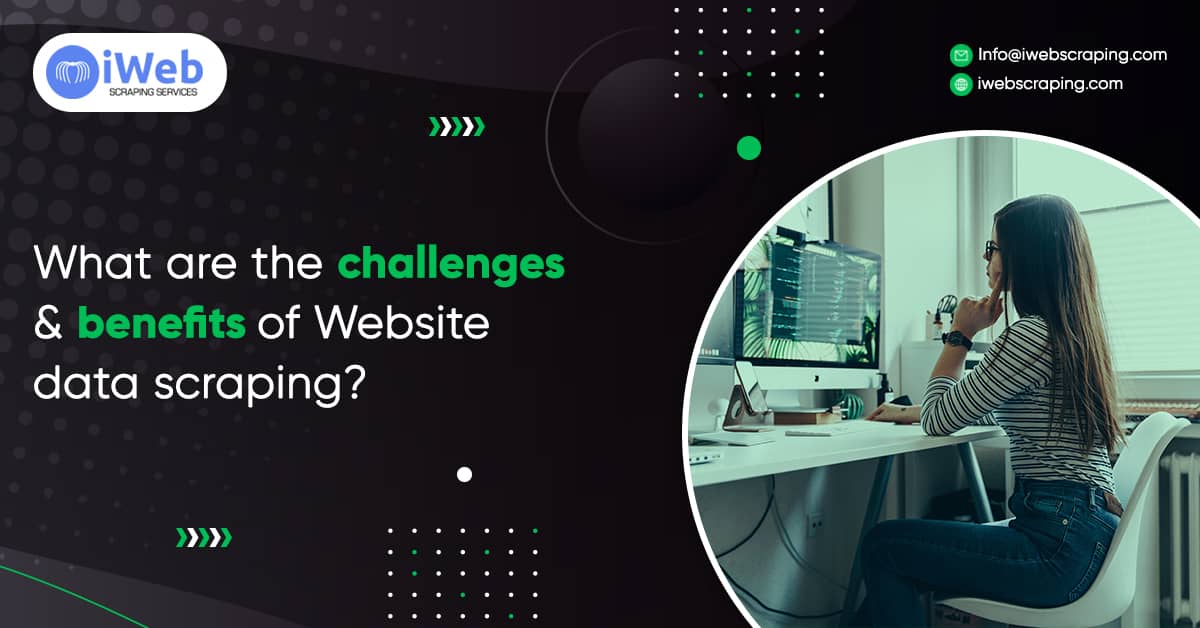What are the challenges and benefits of Website data scraping?

Scraping websites is a process that allows you to extract data from the internet without ever creating an account or logging in. Whether this process is a good idea depends on the data type and if it is publicly available. Data scrapers may also face several challenges related to copyright infringement, liability, and legal issues.
Suppose you are considering scraping a website for information. In that case, it is essential to understand its definition, benefits, and challenges and whether web scraping will benefit your situation. This post will explain the considerations of such activity and what you should know about it.
What is Website Data Scraping?

Website scraping allows you to extract data from websites without registering or logging in. The process usually involves two primary steps: gathering all URLs on the target website and generating a list of those URLs with their associated data.
The main benefit of scraping is that it allows access to information that might not be available through normal means, such as web archives, author pages, and comment sections. For example, using its scraping tools, you can extract millions of RSS feeds from a website.
Note that the information you scrape from their website will not contain any extra metadata or behind-the-scene comments made by people working within that organization.
Most commonly faced challenges during Web data scraping

Identifying and scraping the right page is difficult, as all the available links need to be displayed by search engines. Even if we find the right page, it might contain unwanted text, or the desired text might appear far from the top.
For example, in the case of a forum or news article, scrapers must consider all the comments in their search results when deciding which link to follow.
- Exact extraction of data is always challenging for web scrapers. They must consider minor font size changes and background colors while extracting the required information.
- Web spiders do not work on most websites, so while downloading information, you may face an error page that prevents web crawlers from breaking into that website again.
- Safe data extraction: It is essential to alter the page structure to extract the required information in a proper format without breaking any layout rules.
- Several security issues may emerge, including session hijacking and cross-site scripting attacks that allow for stealing your credentials or manipulating your personal information.
- Sorting relevant results from irrelevant ones is always a challenge facing web scrapers, as search engines only show their best guess of what we typed in our search form, not a list of complete results.
- Private websites like social networking or company websites are copyrighted, so it is essential to understand the legal implications of web scraping. These sites usually provide ways to access data but do not allow scraping.
Methods To Avoid Blocking:

A website intended to scrape might restrict that action by various means. It might employ a protection system that uses a honeypot. A honeypot is a trap set to detect rule violations and record each offender's IP address. Some websites are designed to protect data by blocking unauthorized access (using CAPTCHAs) or limiting the number of search requests per second.
- Following search engine crawlers: Search engines like Google use web spiders to index the world wide web. So, it can be a good idea to follow these crawlers to find out which pages are up-to-date. The problem with this method is that the crawler will not include low-level information like meta tags, pagination, and comments in the final result.
- Limit the number of requests per second: High-end databases and high-volume websites usually check for requests per second (RPS). So, rather than scraping all data from a website at once, it is better to scrape enough data needed for your research and limit your RPS.
- Another method to prevent web scraping is rotating or removing the login credentials daily. Web scrapers will be unable to access the website due to a lack of updated credentials.
- Using CAPTCHAs: An alternative to honeypots is a CAPTCHA, which may consist of distorted text, an image of a scanned word, or an audio challenge. These measures sometimes take the form of simple puzzles such as counting the number of words or letter E's in a block of text, though what they all have in common is that they aim to detect whether the user is human rather than a computer program.
- Using Robots.txt: Robot Exclusion Protocol (REP) allows website owners to inform the major search engines about their intention for a specific page or directory. Websites can also employ other measures to refuse access to undesirable automated processes.
- Using CAPTCHAs and IP address blocking: It is a good idea to limit search requests per second when scraping websites that contain large amounts of data, as these functions might prevent you from breaking into the website again in a short period.
- A good option is to generate fake personal information and passwords, then save those pieces of information in an Excel file, which is accessible later.
Benefits of data scraping:

A small business can get its product or service listed in Google search results, which would be an excellent way to generate traction. Data scraping enables you to find new products and services that can later be sold online. This process is called data mining and is used by many companies in their research and development departments. You can also use it to update websites with the latest web content from other websites, preventing website owners from spending hours updating their pages daily.
- The data extraction provides a unique perspective from the actual data. Use it for filtering, scoring, clustering, and other predictive analysis.
- It can significantly reduce the time needed for building search engine indexes, as most of the research takes place at the database level, and it is not necessary to crawl hundreds or thousands of individual websites.
- Scraping websites allows you to quickly create up-to-date search engine indexes of all websites, which can be useful for keyword rank checking after crawling is complete.
- By scraping a website, it is possible to build interactive, detailed data tables, which might help develop a search engine that allows people to search all the pages within a website.
- You can use website scraping for testing new site A/B testing (server-side) and business intelligence dashboards (client-side).
- When crawling is complete, it can pull out fresh content from a website with an existing blog, e-commerce store, or social media platform.
- Scraping is very helpful for making accurate marketing plans and campaigns. This technique involves analyzing web pages to find websites that are vulnerable or deficient in some aspect that needs improvement or repair.
Conclusion
Web crawling is a technique that may work on a large scale, but web scraping can be categorized as an advanced technique that can help, as it requires resources to implement and manage. Web crawlers build search engine indexes by analyzing web pages and extracting relevant information, while web scrapers extract data and analyze the data or the links in the website.
The bottom line is that if you want to scrape data from websites and deliver it to end users in the proper format, you need many tools, techniques, and patience. It is better to use scraping as an additional data analysis technique than rely solely on it for data extraction purposes.
